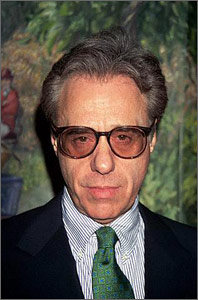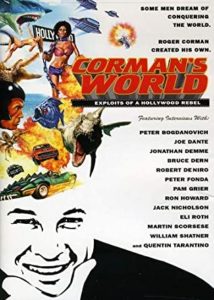 Over the past decade, I’ve spoken to director Peter Bogdanovich a bunch of times concerning a handful of his projects, ranging from 2002’s Cat’s Meow and his acting work in TV’s The Sopranos to his earlier directorial efforts Daisy Miller (1974), Nickelodeon (1976) and 1981’s They All Laughed (his personal favorite film), .
Over the past decade, I’ve spoken to director Peter Bogdanovich a bunch of times concerning a handful of his projects, ranging from 2002’s Cat’s Meow and his acting work in TV’s The Sopranos to his earlier directorial efforts Daisy Miller (1974), Nickelodeon (1976) and 1981’s They All Laughed (his personal favorite film), .
Most recently, Mr. Bogdanovich popped up as an enthusiastic talking head in the 2011 film Corman’s World: Exploits of a Hollywood Rebel (DVD $26.98, Blu-ray $29.99, Anchor Bay) a lively documentary on the legendary (and prolific!) filmmaker Roger Corman. In my most recent chat with Mr. Bogdanovich for Disc Dish, he was only too happy to discuss his career-making association with Corman, who produced Bogdanovich’s first film, the 1968 thriller Targets.
DD: It was great seeing you in Corman’s World! When you were asked to contribute, were you psyched to lend your voice to it?
PB: Absolutely. I owe Roger my entry into the movies. If it wasn’t for him, I don’t know if I would have gotten into the pictures. And because of him, I got into them pretty swiftly. And I’ve campaigned for him to get an Oscar for years.
DD: And he finally got an honorary one in 2009, but they didn’t even broadcast it.
PB: Yeah I don’t like the fact that the special awards are now given at a special dinner. It’s not as impressive.
DD:There are many stories floating around about your first film, Targets, and how Corman produced it and got you on the set of one of his previous films, The Terror (1966), and so on. Can you tell me about the actual days of the production? Was Mr. Corman right there on-set or popping in to give you any specific advice?
PB: Roger never came on the set at all, and he never looked at dailies. He didn’t see the film until the first cut was put together. He liked the script a lot, though he wasn’t happy that he had to pay Karloff for an extras three days, because it was supposed to be Karloff for only two days. The original plan was to use footage of Karloff from The Terror, but I couldn’t really use it. So we ended up having Karloff for five days and we shot all his stuff. And it’s still hard to believe we did it in only five days! Karloff liked the script a lot and was very cooperative.
DD: And Sam Fuller (The Naked Kiss) gave you a hand on the script?
PB: Yes, well, I had sent Sammy the script to ask him his opinion on it. He called me up and said, ‘Come on over to the shack,” which meant to come over to his house.
DD: Sounds like something he would say.
PB: So I get there and the first thing he says is, ‘Why do you kill Karloff half-way through the picture?’ So I told him that I only had two days with Karloff and he said, ‘Don’t ever think about limitations when you’re writing a script—figure it out when you’re going to shoot it. You can’t kill him off—he’s the star.’ And then he proceeded to rewrite the script as he paced up and down in his house.
 DD: With a cigar, I’m assuming?
DD: With a cigar, I’m assuming?
PB: Oh yeah. And a glass of vodka. And he basically rewrote the whole script and came up with the ending. We spent about two-and-a-half hours together and when it was all over, I told him that I had to give him credit for it because he rewrote so much of it. And he told me that if I gave him credit, they’d think he did the whole thing. ‘No credit, kid,’ he said. I was able to repay the favor a few years when he needed some money and I loaned him some bread. And I also helped him get The Big Red One (1980) done. There was no way to repay him for all he did because his help really helped to launch my career.
DD: And a young László Kovács (No Subtitles Necessary) was your cinematographer for Targets…
PB: László had been taking credit as ‘Leslie Kovacks’ up to that point. I asked him, ‘Why do you call yourself Leslie?’ And he said, ‘When I make a picture I really like, I’ll call myself Laszlo.’ So Targets was the first film when he used his real name. He ended up shooting five of my other films—What’s Up Doc? (1972), Paper Moon (1973), At Long Last Love (1975), Nickelodeon (1976) and Mask (1976). I did more films with Laszlo than anyone else.
DD: People are always talking about the “legend” of Roger Corman—his prodigious output, his feel for the marketplace and the marketing of his films, his focus on genre, and all that. But his skills at directing aren’t discussed as much. What do you think are his strongest assets as a filmmaker?
PB: He knows how to tell a story—there’s a lot of energy in his storytelling. From Roger, I learned a lot about keeping a film set moving and how to shoot just what you need as opposed to a lot of coverage.
DD: What are your favorite films that he’s directed?
PB: I liked his Poe pictures—House of Usher (1960) and The Masque of the Red Death (1964), which are the best of the bunch for me. I liked The Wild Angels (1966), which I’m a little prejudiced about because I worked on it. And I liked The Trip (1967) and The Intruder (1962), which is a good picture. Roger knows what he’s doing, that’s for sure.
|
Buy or Rent Corman’s World
|
|||
|---|---|---|---|
DVD |
 DVD | Blu-ray DVD | Blu-ray |
 DVD | Blu-ray DVD | Blu-ray |
|
Leave a Reply